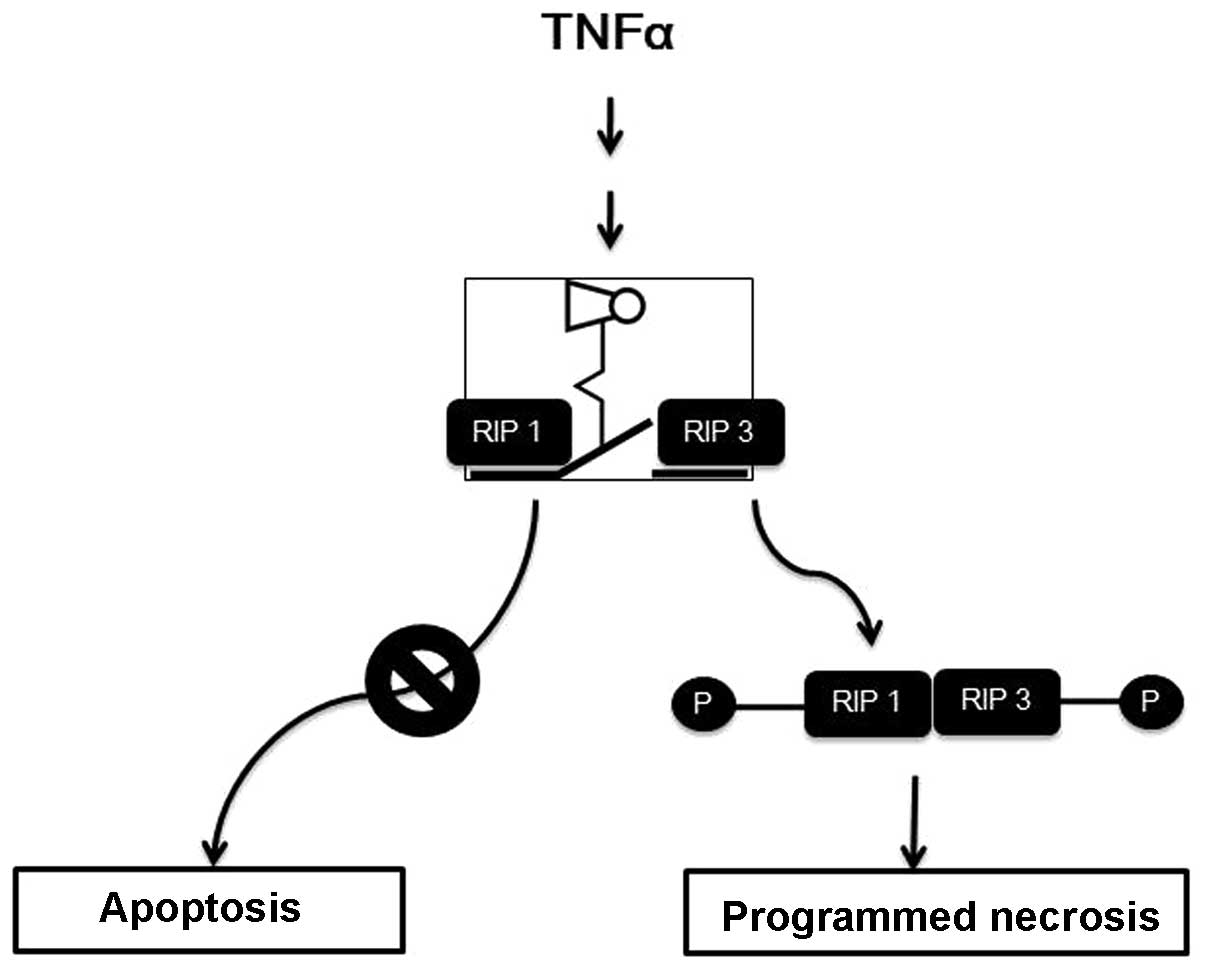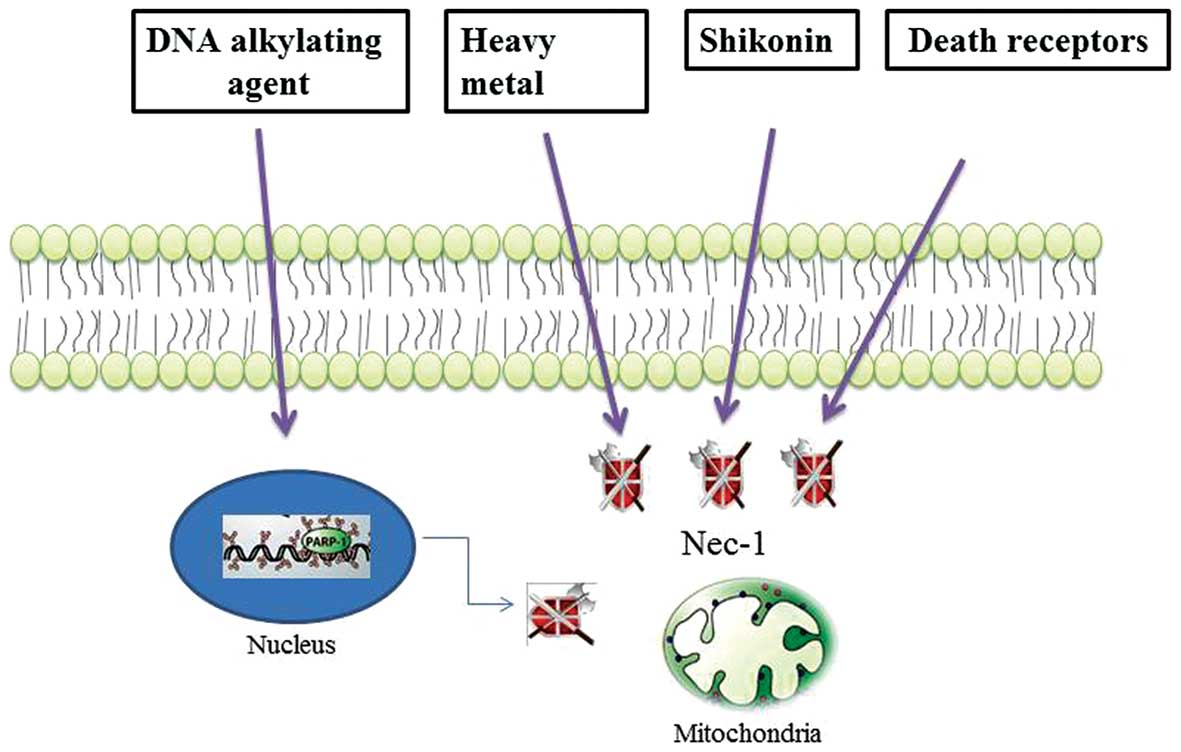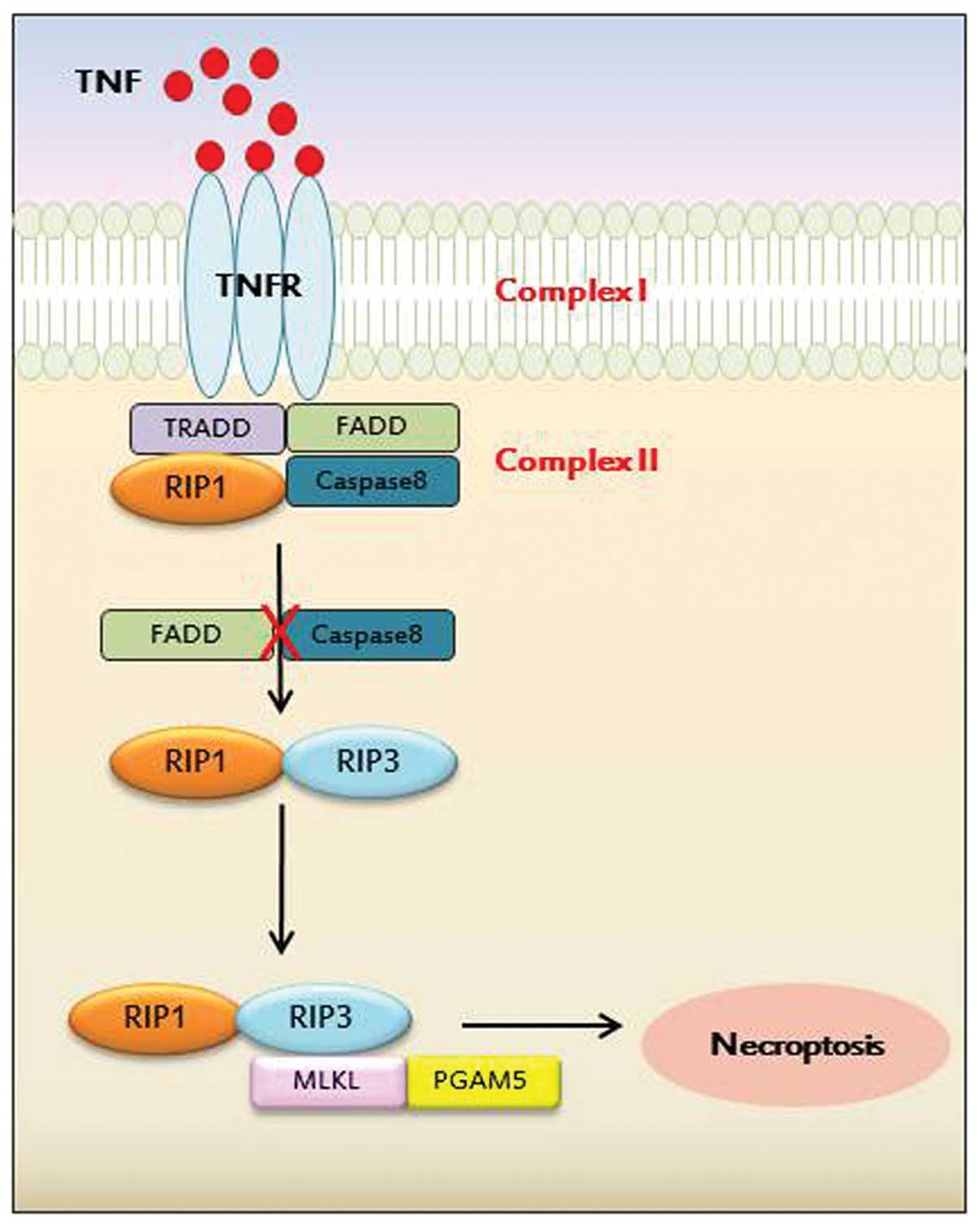|
1
|
Iyer SS, Pulskens WP, Sadler JJ, et al:
Necrotic cells trigger a sterile inflammatory response through the
Nlrp3 inflammasome. Proc Natl Acad Sci USA. 106:20388–20393. 2009.
View Article : Google Scholar : PubMed/NCBI
|
|
2
|
Xu Y, Huang S, Liu ZG and Han J:
Poly(ADP-ribose) polymerase-1 signaling to mitochondria in necrotic
cell death requires RIP1/TRAF2-mediated JNK1 activation. J Biol
Chem. 281:8788–8795. 2006. View Article : Google Scholar : PubMed/NCBI
|
|
3
|
Petit F, Arnoult D, Viollet L and
Estaquier J: Intrinsic and extrinsic pathways signaling during
HIV-1 mediated cell death. Biochimie. 85:795–811. 2003. View Article : Google Scholar : PubMed/NCBI
|
|
4
|
Cho YS, Park SY, Shin HS and Chan FK:
Physiological consequences of programmed necrosis, an alternative
form of cell demise. Mol Cells. 29:327–332. 2010. View Article : Google Scholar : PubMed/NCBI
|
|
5
|
Rangamani P and Sirovich L: Survival and
apoptotic pathways initiated by TNF-α: modeling and predictions.
Biotechnol Bioeng. 97:1216–1229. 2007.
|
|
6
|
Lamkanfi M, Festjens N, Declercq W, Vanden
Berghe T and Vandenabeele P: Caspases in cell survival,
proliferation and differentiation. Cell Death Differ. 14:44–55.
2007. View Article : Google Scholar : PubMed/NCBI
|
|
7
|
Li Y, Yang X, Ma C, Qiao J and Zhang C:
Necroptosis contributes to the NMDA-induced excitotoxicity in rat’s
cultured cortical neurons. Neurosci Lett. 447:120–123.
2008.PubMed/NCBI
|
|
8
|
Scholz C, Wieder T, Stärck L, et al:
Arsenic trioxide triggers a regulated form of caspase-independent
necrotic cell death via the mitochondrial death pathway. Oncogene.
24:1904–1913. 2005. View Article : Google Scholar : PubMed/NCBI
|
|
9
|
Krumschnabel G, Ebner HL, Hess MW and
Villunger A: Apoptosis and necroptosis are induced in rainbow trout
cell lines exposed to cadmium. Aquat Toxicol. 99:73–85. 2010.
View Article : Google Scholar : PubMed/NCBI
|
|
10
|
Hitomi J, Christofferson DE, Ng A, et al:
Identification of a molecular signaling network that regulates a
cellular necrotic cell death pathway. Cell. 135:1311–1323. 2008.
View Article : Google Scholar : PubMed/NCBI
|
|
11
|
Baritaud M, Cabon L, Delavallée L, et al:
AIF-mediated caspase-independent necroptosis requires ATM and
DNA-PK-induced histone H2AX Ser139 phosphorylation. Cell Death Dis.
3:e3902012. View Article : Google Scholar : PubMed/NCBI
|
|
12
|
Park S, Shin H and Cho Y: Shikonin induces
programmed necrosis-like cell death through the formation of
receptor interacting protein 1 and 3 complex. Food Chem Toxicol.
55:36–41. 2013. View Article : Google Scholar : PubMed/NCBI
|
|
13
|
Hsu TS, Yang PM, Tsai JS and Lin LY:
Attenuation of cadmium-induced necrotic cell death by
necrostatin-1: potential necrostatin-1 acting sites. Toxicol Appl
Pharmacol. 235:153–162. 2009. View Article : Google Scholar : PubMed/NCBI
|
|
14
|
De Murcia G, Schreiber V, Molinete M, et
al: Structure and function of poly(ADP-ribose) polymerase. Mol Cell
Biochem. 138:15–24. 1994.
|
|
15
|
Lautier D, Lagueux J, Thibodeau J, Ménard
L and Poirier GG: Molecular and biochemical features of poly
(ADP-ribose) metabolism. Mol Cell Biochem. 122:171–193. 1993.
View Article : Google Scholar
|
|
16
|
Gobeil S, Boucher CC, Nadeau D and Poirier
GG: Characterization of the necrotic cleavage of poly(ADP-ribose)
polymerase (PARP-1): implication of lysosomal proteases. Cell Death
Differ. 8:588–594. 2001. View Article : Google Scholar : PubMed/NCBI
|
|
17
|
Holler N, Zaru R, Micheau O, et al: Fas
triggers an alternative, caspase-8-independent cell death pathway
using the kinase RIP as effector molecule. Nat Immunol. 1:489–495.
2000. View Article : Google Scholar : PubMed/NCBI
|
|
18
|
Cho YS, Challa S, Moquin D, et al:
Phosphorylation-driven assembly of the RIP1-RIP3 complex regulates
programmed necrosis and virus-induced inflammation. Cell.
137:1112–1123. 2009. View Article : Google Scholar : PubMed/NCBI
|
|
19
|
He S, Wang L, Miao L, et al: Receptor
interacting protein kinase-3 determines cellular necrotic response
to TNF-α. Cell. 137:1100–1111. 2009.PubMed/NCBI
|
|
20
|
Zhang DW, Shao J, Lin J, et al: RIP3, an
energy metabolism regulator that switches TNF-induced cell death
from apoptosis to necrosis. Science. 325:332–336. 2009. View Article : Google Scholar : PubMed/NCBI
|
|
21
|
Narayan N, Lee IH, Borenstein R, et al:
The NAD-dependent deacetylase SIRT2 is required for programmed
necrosis. Nature. 492:199–204. 2012. View Article : Google Scholar : PubMed/NCBI
|
|
22
|
Sun L, Wang H, Wang Z, et al: Mixed
lineage kinase domain-like protein mediates necrosis signaling
downstream of RIP3 kinase. Cell. 148:213–227. 2012. View Article : Google Scholar : PubMed/NCBI
|
|
23
|
Galluzzi L and Kroemer G: Necroptosis: a
specialized pathway of programmed necrosis. Cell. 135:1161–1163.
2008. View Article : Google Scholar : PubMed/NCBI
|
|
24
|
Baines CP: Role of the mitochondrion in
programmed necrosis. Front Physiol. 1:1562010. View Article : Google Scholar : PubMed/NCBI
|
|
25
|
Wang Z, Jiang H, Chen S, Du F and Wang X:
The mitochondrial phosphatase PGAM5 functions at the convergence
point of multiple necrotic death pathways. Cell. 148:228–243. 2012.
View Article : Google Scholar : PubMed/NCBI
|
|
26
|
Teng X, Degterev A, Jagtap P, et al:
Structure-activity relationship study of novel necroptosis
inhibitors. Bioorg Med Chem Lett. 15:5039–5044. 2005. View Article : Google Scholar : PubMed/NCBI
|
|
27
|
Degterev A, Huang Z, Boyce M, et al:
Chemical inhibitor of nonapoptotic cell death with therapeutic
potential for ischemic brain injury. Nat Chem Biol. 1:112–119.
2005. View Article : Google Scholar : PubMed/NCBI
|
|
28
|
Degterev A, Hitomi J, Germscheid M, et al:
Identification of RIP1 kinase as a specific cellular target of
necrostatins. Nat Chem Biol. 4:313–321. 2008. View Article : Google Scholar : PubMed/NCBI
|
|
29
|
Jagtap PG, Degterev A, Choi S, Keys H,
Yuan J and Cuny GD: Structure-activity relationship study of
tricyclic necroptosis inhibitors. J Med Chem. 50:1886–1895. 2007.
View Article : Google Scholar : PubMed/NCBI
|
|
30
|
Wang K, Li J, Degterev A, Hsu E, Yuan J
and Yuan C: Structure-activity relationship analysis of a novel
necroptosis inhibitor, necrostatin-5. Bioorg Med Chem Lett.
17:1455–1465. 2007. View Article : Google Scholar : PubMed/NCBI
|
|
31
|
Teng X, Keys H, Jeevanandam A, et al:
Structure-activity relationship study of [1,2,3]thiadiazole
necroptosis inhibitors. Bioorg Med Chem Lett. 17:6836–6840.
2007.
|
|
32
|
Zheng W, Degterev A, Hsu E, Yuan J and
Yuan C: Structure-activity relationship study of a novel
necroptosis inhibitor, necrostatin-7. Bioorg Med Chem Lett.
18:4932–4935. 2008. View Article : Google Scholar : PubMed/NCBI
|
|
33
|
Smith CC, Davidson SM, Lim SY, Simpkin JC,
Hothersall JS and Yellon DM: Necrostatin: a potentially novel
cardioprotective agent? Cardiovasc Drugs Ther. 21:227–233. 2007.
View Article : Google Scholar : PubMed/NCBI
|
|
34
|
You Z, Yang J, Takahashi K, et al: Reduced
tissue damage and improved recovery of motor function after
traumatic brain injury in mice deficient in complement component
C4. J Cereb Blood Flow Metab. 27:1954–1964. 2007. View Article : Google Scholar : PubMed/NCBI
|
|
35
|
Choi JM, Park KM, Kim SH, et al: Effect of
necrosis modulator necrox-7 on hepatic ischemia-reperfusion injury
in beagle dogs. Transplant Proc. 42:3414–3421. 2010. View Article : Google Scholar : PubMed/NCBI
|
|
36
|
Gorman AM: Neuronal cell death in
neurodegenerative diseases: recurring themes around protein
handling. J Cell Mol Med. 12:2263–2280. 2008. View Article : Google Scholar : PubMed/NCBI
|
|
37
|
Gukovskaya AS, Mareninova OA, Odinokova
IV, et al: Cell death in pancreatitis: effects of alcohol. J
Gastroenterol Hepatol. 21(Suppl 3): S10–S13. 2006. View Article : Google Scholar
|
|
38
|
Mareninova OA, Sung KF, Hong P, et al:
Cell death in pancreatitis: caspases protect from necrotizing
pancreatitis. J Biol Chem. 281:3370–3381. 2006. View Article : Google Scholar : PubMed/NCBI
|
|
39
|
Kennedy CL, Smith DJ, Lyras D, Chakravorty
A and Rood JI: Programmed cellular necrosis mediated by the
pore-forming α-toxin from clostridium septicum. PLoS Pathog.
5:e10005162009.
|
|
40
|
Yuan J: Neuroprotective strategies
targeting apoptotic and necrotic cell death for stroke. Apoptosis.
14:469–477. 2009. View Article : Google Scholar : PubMed/NCBI
|














